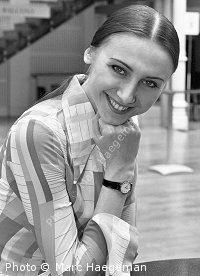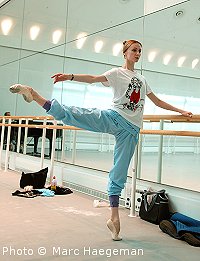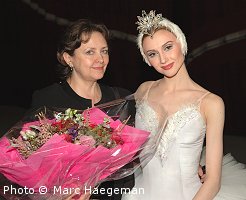Steely strength with a silken appearance
An interview with Svetlana Zakharova, principal dancer of the Bolshoi Ballet

For the frail-looking but determined girl from Lutsk, a small city in the Ukraine, who at first didn’t even want to be a dancer, it is a totally unexpected turn of events. "It wasn’t my dream to become a ballerina, Zakharova reminisces. There wasn’t even a ballet theatre in my hometown. My mother wanted me to be dancer - she had danced a little when she was young - but I didn’t. Of course when I saw how beautiful everything was at the school, I was won over."
Yet her first steps in the world of dance were as inauspicious as possible: "At the age of ten I auditioned for the Kiev Ballet School. I was accepted, but already after a few months I had to leave the school again, because as a result of a new assignment of my dad who was in the army, my parents moved to East-Germany. When the Soviet Union collapsed, the army was pulled out of Germany and so we all returned home and I went back to school." She concludes laughingly: "If it hadn’t been for Mikhail Gorbachov, I would probably never have been a ballerina."
Having completed six years at the Kiev School, Zakharova was prepared to take part in the International Young Dancers' Competition in St. Petersburg. She won second prize with her performance of Princess Florine in the Blue Bird Pas de Deux from Tchaikovsky's Sleeping Beauty and variations from Paquita and Balanchine's Tchaikovsky Pas de Deux. And from then on things started going really fast.
"As a result I was invited to finish my studies at the Vaganova Academy, immediately in the third, the graduating course, instead of the expected second. So in fact I ended one year before my time, I was 17 while I should have been 18." She already danced before her graduation on the Mariinsky Theatre stage and upon graduation she quite naturally joined the Kirov Ballet.

"At the Mariinsky I was engaged in the corps de ballet, although I hardly did anything there. Instead I immediately started dancing coryphée roles - lots and lots of big swans, fairies, groups of three, groups of four. My first big assignment was Maria in The Fountain of Bakhchisarai. When I was 18, I officially became a soloist. And from that point on it were leading roles all the time."
And they came in a mind-boggling tempo: the title role in Giselle at 17, Princess Aurora in The Sleeping Beauty and Balanchine’s Serenade at 18, Odette/Odile in Swan Lake and Balanchine’s Symphony in C at 19, Nikiya in La Bayadère at 20… Her performance of Giselle earned her a nomination for the Golden Mask, Russia’s most prestigious theatrical award. She won the award for Serenade and the next year for The Sleeping Beauty.
"Physically it was extremely hard for me, Zakharova remembers. I felt always totally exhausted after a performance." The big classics, but also the newly acquired Balanchine ballets proved a tremendous challenge for the young dancer, who is only now confident to say: "I now feel very close to Balanchine, I danced nearly everything Balanchine they have in the Mariinsky repertory."
Time was crucial for Zakharova, yet time was about the only thing the Kirov wasn’t prepared to give. In this respect her coach Olga Moiseyeva – who groomed among others Altynai Asylmuratova and Galina Mezentseva – was of fundamental importance for the young dancer just out of school: "Olga Nikolayevna [Moiseyeva] was the one who helped me to grow up as a ballerina. From the beginning she has been a major support to me and she taught me to develop my taste for this art as well as the notion of style. Even when I left for the Bolshoi, she assured me I was doing the right thing. Of course we still keep in touch."
Svetlana Zakharova stunned the Russian dance world by leaving the Kirov for the Bolshoi in the summer of 2003. Of course, she wasn’t the first Petersburg artist to continue her career in Moscow – Marina Semyonova, Galina Ulanova, Yuri Grigorovich, Nina Timofeyeva, and Ludmilla Semenyaka are just a few who had successfully shown the way. But the decision was neither easy nor obvious. "The Bolshoi approached me several times when I was dancing with the Mariinsky. Even already in my first season in St. Petersburg, they wanted me to come and join the Bolshoi. But I felt anything but ready at that point. I was 17 and couldn’t possibly feel comfortable with such a weighty decision." It was only after seven seasons and as an established star that she was finally convinced: "I felt the time was ripe to change theatre and city. I needed new challenges and prospects. The director offered me excellent working conditions and a great deal of freedom to take on any private work, to freelance with other companies as much as I like."
Zakharova admits she was feeling quite nervous about the transfer. There was also the question of finding a suitable coach at the Bolshoi. It turned out to be Ludmilla Semenyaka, the former star ballerina, whom she met rather accidentally: "I was invited by the Bolshoi Theatre for a guest performance, but since I was still with the Mariinsky at that time I didn’t have any repetiteur in Moscow. My partner, Nikolai Tsiskaridze, pointed out Ludmilla Semenyaka who happened to be available then. When I returned to dance the Kingdom of the Shades Act in the gala for Marina Semyonova at the Bolshoi I worked with her again. And I am very happy it turned out this way, because we empathise with each other a great deal. Our personalities are very close, we come from the same school and she also moved to Moscow."

Zakharova is of course mostly associated with the big classical roles like Odette-Odile, Nikiya in La Bayadère and Giselle which emphasize her lyrical qualities and time-suspending legato – Tobi Tobias dubbed her "the queen of adagio". Nonetheless, always keen on new challenges, she herself feels very close to the tongue-in-cheek vivacity and exuberance of a role like Kitri in Don Quixote: "I really feel the style of this ballet. Of course anyone who sees me in Swan Lake or Giselle would find it hard to believe it, but I do feel very close to this ballet. When I first danced Kitri everybody was surprised I was able to pull it off." She recently also tackled Maya Plisetskaya’s signature role of Carmen.
Having danced in no less than nine different productions of Swan Lake around the world, Svetlana Zakharova commands this ballet as few else today. One of the ballerina’s main challenges in Swan Lake remains the dual role: "The White Act is of course very profound. There are no limits to the White Act, you can always look for something different and try something better. It builds up and develops on your own feelings, which makes it extra special. The Black Act on the other hand is much more definite and remains very constant all the way through: you come on and you do what you have to do. But in the White Act I am always looking for something new."
And this "always looking for something new", this refreshing approach is exactly what makes Zakharova’s performances such a rewarding experience. The now characteristic blend of steely strength with a silken appearance, the effortlessness, the fluidity of execution, and the genuine sense of purpose, transcending technique and wow-effects, make her one of today’s leading ladies of classical ballet.
Svetlana Zakharova already changed her home several times, and although she could state a few years ago that St. Petersburg had became her new home, when asked again now she replies without hesitation: "Now it is Moscow! My family lives there: my mum, my brother, and I love the city. I have many friends there and I like the warm atmosphere in the Bolshoi Theatre." With that many opportunities to guest all over the world the question of staying and making her home in the West has been raised before, yet at this point she remains adamant: "It’s a difficult thing, because I love Russia so much. I can’t stay away from my home-country for a long time. I become homesick quickly."
August 2004.
Copyright © 2010
Photos and Interview with Svetlana Zakharova Copyright © 2010 Marc Haegeman. All rights reserved.
First published in Dance International, Fall 2006.